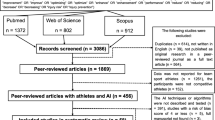Abstract
Sports injuries have been a common concern during athlete training as the number of Chinese athletes and their training intensity have increased. These injuries frequently impact critical locations, including the waist, shoulder, and wrist, impeding training progress and intensity. Inadequate training levels, a lack of understanding of preventive measures, inappropriate movements, insufficient warm-up exercises, low physical condition, and an inability to adjust to the environment all contribute to sports injuries. As a result, athlete training and recovery suffer. To address these issues, this study presents a neural network-based sports injury risk analysis system that uses blockchain and the Internet of Things (IoT). The suggested system combines a multi-sensor data fusion technique based on blockchain and IoT to evaluate and analyze sports injuries completely. The system has three unique roles: coach, team doctor, and athlete, each with its functional modules. Sensors collect data on athletes’ recovery from sports injuries by collecting and analyzing inputs inside the human action system. The system then establishes the output values of a neural network and a risk level table, allowing for the estimation of athletes’ risk levels based on the given table. Comparing the traditional technique and the sports injury rehabilitation monitoring system demonstrates that the technology can reliably detect players’ injury locations in as little as 0.2 s. Furthermore, a thorough examination of the system’s tracking and analysis accuracy reveals a recovery rate of approximately 94.39%, demonstrating minimal fluctuations and improved stability. The experimental findings reveal that combining blockchain, IoT, and neural network technologies makes the proposed sports injury rehabilitation monitoring system useful in quickly recognizing damage positions and enabling accurate tracking and analysis.














Similar content being viewed by others
Data availability
Data are available on reasonable request from the corresponding author.
References
Ali M, Yin B, Kunar A, Sheikh AM, et al. (2020) Reduction of multiplications in convolutional neural networks. In: 2020 39th Chinese control conference (CCC), pp 7406–7411
Araujo B, Ferreira B, Virtuoso LS, Meira-Belo LC, Sebastio RCO (2021) A new formulation for polymer fricke dosimeter and an innovative application of neural network to study dose profile from Spin-Echo NMR data. Radiat Phys Chem 184(4):109444
Aslam MS, Qaisar I (2023) Sensor networks with distributed event-triggered scheme for T–S fuzzy system with dissipativity analysis. Eur J Control 71:100800. https://doi.org/10.1016/j.ejcon.2023.100800
Aslam MS, Tiwari P, Pandey HM, Band SS (2023) Robust stability analysis for class of Takagi–Sugeno (T–S) fuzzy with stochastic process for sustainable hypersonic vehicles. Inf Sci 641:119044. https://doi.org/10.1016/j.ins.2023.119044
Bilal H, Yin B, Aslam MS, Anjum Z, Rohra A, Wang Y (2023a) A practical study of active disturbance rejection control for rotary flexible joint robot manipulator. Soft Comput. https://doi.org/10.1007/s00500-023-08026-x
Bilal H, Yin B, Kumar A, Ali M, Zhang J, Yao J (2023b) Jerk-bounded trajectory planning for rotary flexible joint manipulator: an experimental approach. Soft Comput 27(7):4029–4039
Cao K, Ding H, Li W, Lv L, Gao M, Gong F, Wang B (2022) On the ergodic secrecy capacity of intelligent reflecting surface aided wireless powered communication systems. IEEE Wirel Commun Lett. https://doi.org/10.1109/LWC.2022.3199593
Chen M, Malook T, Rehman AU, Muhammad Y, Alshehri MD, Akbar ABM, Khan MA (2021) Blockchain-enabled healthcare system for detection of diabetes. J Inf Secur Appl 58:102771. https://doi.org/10.1016/j.jisa.2021.102771
Fu Y, Li C, Yu FR, Luan TH, Zhao P, Liu S (2023) A survey of blockchain and intelligent networking for the metaverse. IEEE Internet of Things J. https://doi.org/10.1109/JIOT.2022.3222521
Gotlin MJ, Minhas SV, Buchalter DB, Feder OI, Jazrawi LM (2020) Performance and return to sport after hand, wrist, and forearm fractures in the national hockey league. Arthrosc Sports Med Rehabilitat 2(5):e505–e510
Guo SY, Fang JL (2019) Causes and countermeasures of injuries in mass sports and competitive sports. Contemp Sports Technol 9(9):7–8
Jin KQ, Jia WW (2022) Study on causes and prevention of sports injury among students majoring in physical education in colleges and universities: take Bohai university as an example. Contemp Sports Technol 12(13):18–22
Jing H, Yungang T (2017) Multi-sensor data fusion algorithm based on D–S evidence theory and fuzzy mathematics. Acta Instrum 6:644–647
Kumar A, Shaikh AM, Li Y et al (2021) Pruning filters with L1-norm and capped L1-norm for CNN compression. Appl Intell 51:1152–1160
Lhee SH, Jain R, Sadasivam MM, Kim S, Lee DY (2021) Sports injury and illness incidence among South Korean elite athletes in the 2018 Asian games: a single-physician prospective study of 782 athletes. BMJ Open Sport Exerc Med 7(1):e000689
Li P, Zhu XQ, Li XH, Tong LG (2021) Effects of sports injury prevention training on biomechanics and co-activation characteristics of sprinters’lower limbs. China Sport Sci Technol 57(11):30–37
Mailuhu A, Rijn R, Stubbe JH, Bierma-Zeinstra SMA, Middelkoop MV (2021) Incidence and prediction of ankle injury risk: a prospective cohort study on 91 contemporary preprofessional dancers. BMJ Open Sport Exerc Med 7(2):e001060
Nakano T, Sakai T, Kasuga K (2019) Influence of noncognitive ability scores on physical fitness improvement: an examination using longitudinal data. Med Sci Sports Exerc 51(6S):831
Orchard JW, Meeuwisse W, Derman W, Hgglund M, Bahr R (2020) Sport medicine diagnostic coding system (SMDSC) and the orchard sports injury and illness classification system (OSIICS): revised 2020 consensus versions. Br J Sports Med 54(7):397–401
Perera N, Ida K, Martin H (2021) Motivation for sports participation, injury prevention expectations, injury risk perceptions and health problems in youth floorball players. Knee Surg Sports Traumatol Arthrosc: off J ESSKA 27(11):3722–3732
Romanchuk N, Girard C, Benoit D (2020) 068 Kinematic and neuromuscular predictors of failed landings during unanticipated drop-jumps: implications for injury prevention. Br J Sports Med 54(Suppl 1):A30
Sheping Z, Hongyu D, Zhaozhao L (2018) Blockchain technology: application and problems, J Xi’an Univ Posts Telecommun 23
Towlson C, Salter J, Ade JD, Enright K, Harper LD, Page RM, Malone JJ (2021) Maturity-associated considerations for training load, injury risk, and physical performance in youth soccer: one size does not fit all. Sports Health Sci (English) 10(4):10
Wang JY, Wang F (2019) Investigation and risk warning of sports injury in the elderly in Taiyuan. Chin J Gerontol 39(20):5016–5020
Wang H, Yumei R, Wang H (2018) Research on sports risk assessment method based on big data analysis. Mod Electron Technol 10:140–142
Wang S, Sheng H, Zhang Y, Yang D, Shen J, Chen R (2023) Blockchain-empowered distributed multi-camera multi-target tracking in edge computing. IEEE Trans Ind Inform. https://doi.org/10.1109/TII.2023.3261890
Wang L, Zhai Q, Yin B et al. (2019) Second-order convolutional network for crowd counting. In: Fourth international workshop on pattern recognition, SPIE, Vol. 11198, pp 158–163
Willick SE, Ehn M, Teramoto M, Klatt JWB, Finnoff JT, Saad K, Cushman DM (2021) The national interscholastic cycling association mountain biking injury surveillance system: 40,000 student-athlete-years of data. Curr Sports Med Rep 20(6):291–297
Wu Y, Sheng H, Zhang Y, Wang S, Xiong Z, Ke W (2022) Hybrid motion model for multiple object tracking in mobile devices. IEEE Internet of Things J. https://doi.org/10.1109/JIOT.2022.3219627
Xie QS, Lin P (2022) Discussion on the new idea of functional exercise in rehabilitation and prevention of sports injury. Contemp Sports Technol 12(6):29–31
Yan L, Yin-He S, Qian Y, Zhi-Yu S, Chun-Zi W, Zi-Yun L (2021) Method of reaching consensus on probability of food safety based on the integration of finite credible data on block chain. IEEE Access 9:123764–123776. https://doi.org/10.1109/ACCESS.2021.3108178
Yao W, Guo Y, Wu Y, Guo J (2017) Experimental validation of fuzzy PID control of flexible joint system in presence of uncertainties. In: 2017 36th Chinese control conference (CCC), IEEE, pp 4192–4197
Yin B, Khan J, Wang L, Zhang J, Kumar A (2019) Real-time lane detection and tracking for advanced driver assistance systems. In: 2019 Chinese control conference (CCC), pp 6772–6777
You Y, Zhang LJ (2022) Application of Bayesian regularized BP neural network in air quality index prediction. J Chongqing Univ Sci Technol (nat Sci Ed) 24(1):78–84
Zhang Z (2018) Sports injury rehabilitation monitoring system based on wireless sensor network. Mod Electron Tech 41(21):101–105
Zhang HP, Wang B (2022) Investigation and analysis of the current situation of common sports injury of sports students in college entrance examination. Contemp Sports Technol 12(7):178–181
Zhang Y, Zhang Y, Zhao X, Zhang Z, Chen H (2020) Design and data analysis of sports information acquisition system based on internet of medical things. IEEE Access 8:84792–84805
Funding
This work was not supported by any funds.
Author information
Authors and Affiliations
Corresponding author
Ethics declarations
Conflict of interest
The authors declare that they have no competing interests.
Additional information
Publisher's Note
Springer Nature remains neutral with regard to jurisdictional claims in published maps and institutional affiliations.
Rights and permissions
Springer Nature or its licensor (e.g. a society or other partner) holds exclusive rights to this article under a publishing agreement with the author(s) or other rightsholder(s); author self-archiving of the accepted manuscript version of this article is solely governed by the terms of such publishing agreement and applicable law.
About this article
Cite this article
Li, N., Zhu, X. Design and application of blockchain and IoT-enabled sports injury rehabilitation monitoring system using neural network. Soft Comput 27, 11815–11832 (2023). https://doi.org/10.1007/s00500-023-08677-w
Accepted:
Published:
Issue Date:
DOI: https://doi.org/10.1007/s00500-023-08677-w




